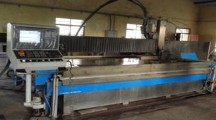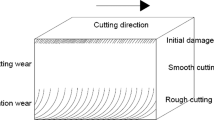Abstract
High pressure waterjet technology has received a wider acceptance for various applications involving machining, cleaning, surface treatment and material cutting. Surface texturing is a popular method to improve the wear resistance of a surface. The present study applied a masked abrasive waterjet texturing process to produce a circular crater on a surface of stainless steel 304. The effect of machining parameters namely traverse rate, water pressure, standoff distance and number of passes on the roughness of the crater surface was analysed. Taguchi method of experimental design was employed by utilizing the L9 orthogonal array. The result shows that the water pressure is the most significant parameter in determining the roughness of the crater surface. Also, based on at the optimum parameters has shown an improvement of surface roughness as compared the initial optimal setting. The optimum parameters to deliver an improved Ra are u at 100 mm/s, p at 100 MPa, s at 5 mm and n at 1. This shows that the Taguchi method can be conveniently used to analyse the surface roughness during the AWJ texturing process of stainless steel 304.
Access provided by Autonomous University of Puebla. Download conference paper PDF
Similar content being viewed by others
Keywords
1 Introduction
The abrasive waterjet (AWJ) machining process has been used widely in many industrial applications. This technology is versatile to the material workpiece and flexible to machining since it has minimal chatter, no heat effect, and imposes minimal stress on the workpiece [1]. Compared with other processes, AWJ machining can machine almost any material since there is no heat damage, minimal force, and environmentally friendly [2]. The fundamental of the AWJ machining mechanism is by jetting a high pressure of water stream combined with abrasive particle force through a nozzle thus removing the surface material [3]. This high-velocity mixture with high kinetic energy jetted from the nozzle impinges the target material, causing the surface material to be eroded. Surface texturing is a technique widely used in industries to improve the surface wear resistance and its friction characteristics [4]. Surface texturing can be defined as purposely producing specific forms and shapes on material surfaces [5]. The surface texturing produces certain design features on surface structure for specific desirable purposes and functions [6]. This purpose includes producing specific surface geometry which affect its tactile friction as well as the look and feel for the sensation to the touch [7].
It is a challenge for AWJ machining process to generate small textures on the surface normally because the crater or channel width has a larger dimension than its waterjet stream diameter approximately greater than 0.5 mm [8]. Micro nozzle is recently available as tiny as 130 μm, nevertheless, reducing the size of nozzle remarkably may cause its blockage and inconsistency in abrasive flow [9]. A potential method to generate a smaller crater size during AWJ surface texturing is using a mask placed on the workpiece surface. Hence, the present study examines the effect of parameters during masked AWJ surface texturing in generating circular craters on the surface of stainless steel.
2 Main Experiment
2.1 Material
The material used in the present study is a commercially available tainless Steel SS304 having dimension of 25 mm (length) × 25 mm (width) × 4 mm (height).
2.2 Equipment
A commercial waterjet cutting machine was used for the entire experiment. It uses a pneumatic-driven water pump with water pressure capacity of up to 200 MPa. A computer numerically controlled (CNC) system manages the movement of the nozzle in 3-dimensional directions. A ruby orifice having a diameter of 0.127 mm and a tungsten carbide focusing tube with diameters and lengths of 0.76 mm and 76.2 mm, respectively, were used for all experiments.
2.3 Experimental Design
The experiment was conducted using Taguchi method. Overall, four machining parameters were selected namely traverse rate (u), water pressure (p), standoff distance (s) and number of passes (n). Additionally, the type of material is also selected as another control factor in the Taguchi's design of experiments. With a total of five control factors, consequently, a L9 orthogonal array with 9 rows which corresponds to the number of experiments was chosen. Table 1 shows the experimental layout using the L9 orthogonal array and their measured surface roughness (Ra) values.
In all experiments, orifice diameter and impact angle were kept constant at 0.127 mm and 90°, respectively. During the experiment, a mask made of stainless steel 304 having a similar dimension and thickness of 2 mm was clamped together with the workpiece. The mask consists of many through holes with a diameter of 1 mm. The jet hits the workpiece by passing through the hole on the mask thus creating a crater over the surface as illustrated in Fig. 1a. The machining parameters were set to the intended levels based on the L9 orthogonal array for each experimental run. Once all the parameters were set to their respective levels, then the workpiece were textured according to the row. Each row represents different experimental run as shown in Fig. 1b. The surface roughness measurement was determined by using a 3D measurement laser microscope (Olympus Lext OLS5000). The average roughness profile of three craters was assessed using the average arithmetic roughness parameters (Ra).
3 Result and Discussion
3.1 Effect of Process Factors on Surface Roughness
An example of 3D surface structure of the crater is shown in Fig. 2a. Its roughness profile is shown in Fig. 2b. The values of Ra for the L9 orthogonal array were determined to be between 3.022 and 6.677 μm as shown in Table 1.
The effect of parameters was analysed based on Taguchi’s signal to noise (S/N) ratio. Based on the information of sample variances, it defines the relationship between the magnitude of the control factor effects and the magnitude of the experimental error [1]. The results of S/N ratio for each parameter in determining the crater surface roughness are shown in Table 2. It is ranked according to the criteria of having a smaller Ra is better (i.e., smaller the better). It can be observed that the pressure has the most significant effect on the surface roughness of the crater surface. It is then followed by the traverse speed and the number of passes. The standoff distance has the least significant effect on the surface roughness.
Figure 3 shows the main effect plot for S/N ratios. The mean S/N ratio shows the relative effects of various parameters on Ra during the AWJ surface texturing process, where a higher value of the mean S/N ratio is considered as a better quality characteristic [1]. According to Fig. 3, the optimum parameters for resulting in a smoother surface of the crater are given by the combination of traverse speed at 100 mm/s, pressure at 100 MPa, standoff distance at 5 mm and the number of passes at 1. A confirmation test was later conducted at the optimum combination of parameters. This test is used to verify the improvement of Ra against the initial parameter setting at middle levels for all parameters (i.e., u at 100 mm/s, p at 75 MPa, s at 10 mm and n at 2). It was found that the Ra at the optimum parameters has improved to 3.12 µm from the initial optimal setting with Ra of 3.5698 µm. 3D structure of the crater surface at optimum parameters is shown in Fig. 4a. Its roughness profile is shown in Fig. 4b. Although, the Ra at the optimum parameters is slightly higher than experiment number 9 with Ra of 3.022 µm, the difference is almost negligible. Therefore, this shows that Taguchi’s S/N ratios can be conveniently used to optimize the surface roughness during the AWJ texturing process of stainless steel 304.
3.2 Modeling
In the present study, the predictive model based on linear regression analysis for Ra as a function of traverse speed, pressure, standoff distance, and the number of passes was developed using Minitab software tools. The predictive model is shown in Eq. 1.
The residual plot was used to check the significance of the predicted model. The capability of the model was determined by the value of R2, which was found about 0.71. This value is closer to 1 thus indicating that the model is capable to sufficiently predict the surface roughness of the crater within the limit of the present study [10]. The residual plot for the study is shown in Fig. 5. The plot shows that the residual falls nearly straight line thus suggesting the significance of the model produced.
4 Conclusion
The optimization of the parameters in producing a smoother circular crater during AWJ texturing process of stainless steel 304 was successfully conducted using the Taguchi method. The optimum parameters to deliver an improved Ra are u at 100 mm/s, p at 100 MPa, s at 5 mm and n at 1. The optimum parameters have shown an improvement of surface roughness as compared the initial optimal setting. This shows that the Taguchi method can be conveniently used to analyse the surface roughness during the AWJ texturing process of stainless steel 304.
References
Azmir MA, Ahsan AK (2008) Investigation on glass/epoxy composite surfaces machined by abrasive water jet machining. J Mater Process Technol 198(1–3):122–128
Folkes J (2009) Waterjet—an innovative tool for manufacturing. J Mater Process Technol 209(20):6181–6189
Supriya SB, Srinivas S (2018) Machinability studies on stainless steel by abrasive water jet—review. Mater Today Proc 5(1):2871–2876
Won SJ, Kim HS (2019) Effects of laser parameters on morphological change and surface properties of aluminum alloy in masked laser surface texturing. J Manuf Process 48(May):260–269
Gropper D, Wang L, Harvey TJ (2016) Hydrodynamic lubrication of textured surfaces: a review of modeling techniques and key findings. Tribol Int 94:509–529
Stout KJ, Blunt L (2001) A contribution to the debate on surface classifications—random, systematic, unstructured, structured and engineered. Int J Mach Tools Manuf 41(13–14):2039–2044
Van Kuilenburg J, Masen MA, Groenendijk MNW, Bana V, Van Der Heide E (2012) An experimental study on the relation between surface texture and tactile friction. Tribol Int 48:15–21
Husin H, Nawi MNM, Gebremariam MA, Azhari A (2021) Investigation on the use of mask in waterjet surface texturing of stainless steel BT—recent trends in manufacturing and materials towards Industry 4.0, pp 519–525.
Melentiev R, Fang F (2018) Recent advances and challenges of abrasive jet machining. CIRP J Manuf Sci Technol 22:1–20
Sivaiah P, Chakradhar D (2019) Modeling and optimization of sustainable manufacturing process in machining of 17–4 PH stainless steel. Meas J Int Meas Confed 134:142–152
Acknowledgements
The present work is supported by the funding from the Ministry of Higher Education Malaysia through FRGS/1/2019/TK03/UMP/02/25 (RDU1901161).
Author information
Authors and Affiliations
Corresponding author
Editor information
Editors and Affiliations
Rights and permissions
Copyright information
© 2022 The Author(s), under exclusive license to Springer Nature Singapore Pte Ltd.
About this paper
Cite this paper
Husin, H., Zaidi, N., Gebremariam, M.A., Azhari, A. (2022). Effect of Masked Abrasive Waterjet Texturing on Surface Roughness Using Taguchi Method. In: Abdul Sani, A.S., et al. Enabling Industry 4.0 through Advances in Manufacturing and Materials. Lecture Notes in Mechanical Engineering. Springer, Singapore. https://doi.org/10.1007/978-981-19-2890-1_12
Download citation
DOI: https://doi.org/10.1007/978-981-19-2890-1_12
Published:
Publisher Name: Springer, Singapore
Print ISBN: 978-981-19-2889-5
Online ISBN: 978-981-19-2890-1
eBook Packages: Chemistry and Materials ScienceChemistry and Material Science (R0)









